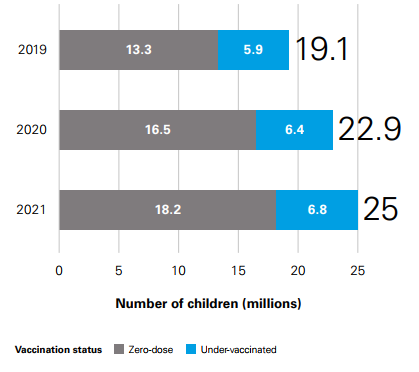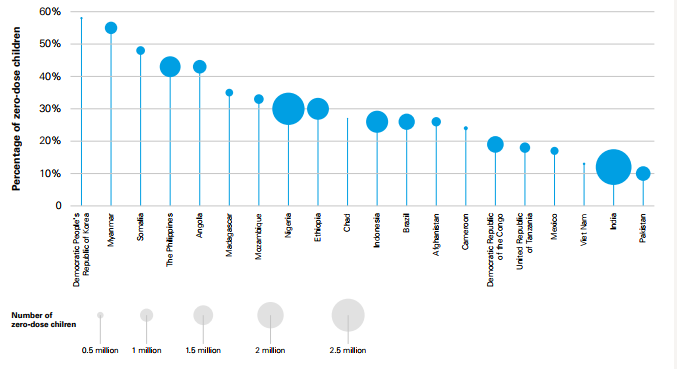Between 2019 and 2021, 1 in 5 children are unvaccinated. UNICEF estimates that 67 million children missed out entirely or partially on routine immunization. 48 million of them missed out entirely. The covid-19 pandemic interrupted childhood vaccination almost everywhere, setting back vaccination rates to levels not seen since 2008.

The State of the World’s Children 2023, published by UNICEF reveals that 1 in 5 children are unvaccinated or ZERO-DOSE (Unvaccinated) or under-vaccinated, leaving them vulnerable to a range of vaccine-preventable diseases. When we don’t vaccinate children, we risk their lives and health– as well as our societies’ growth and development. Vaccines help children thrive, support families and caregivers, and benefit the health of the wider community.



Zero-dose refers to children who have not received any vaccinations. Most live in communities that experience multiple deprivations. Under-vaccinated refers to children who have received some, but not all, of their recommended schedule of vaccinations.
WIDER IMPACT OF VACCINE
Vaccines save 4.4 million lives every year. This figure could rise to 5.8 million by 2030 if the Immunization Agenda 2030 (IA 20230) are met. Over the past decade or so, despite growing efforts to expand immunization, there has been little progress in reducing the number of zero-dose children. Reaching every child remains a challenge, UNICEF said.
Before the introduction of a vaccine in 1963, measles killed an estimated 2.6 million people globally every year, mostly children. By 2021, that had fallen to 128,000 – still too high, but a remarkable improvement.

Vaccines protect children against illness. That helps prevent absences from school, which improves learning outcomes. When children are protected against illness, parents, mostly mothers need to take less time off work to care for sick children.
Families are also less likely to face the emotional pain and sometimes catastrophic costs of caring for a sick child. Vaccinating children supports the health of the wider community by promoting herd immunity and helping to limit the spread of antimicrobial resistance. Vaccines deliver an unrivaled return on investment.
Poverty and zero-dose
In the poorest households, just over 1 in 5 children are zero-dose; in the wealthiest, it is just 1 in 20. In some regions, the gap is even greater: In West and Central Africa, almost 1 in 2 children in the poorest households are zero-dose, compared with around 1 in 16 in the wealthiest. Children of mothers with no or little education are much less likely to be vaccinated.
Top 20 countries with the largest numbers of zero-dose children
The democratic People’s Republic of Korea is ahead in the top 20 countries with the largest numbers of Zero-dose children. India and Pakistan are also placed on this list. The number of Zero-dose children in India is around 2.5 million, the highest in the world, according to the report, whereas in Pakistan this is around 1 million.

The world is facing a red alert for children’s health. Vaccination coverage dropped sharply during the COVID-19 pandemic, leaving millions more children unprotected against some of childhood’s most serious diseases. Catch-up and recovery are urgently needed to vaccinate the children missed and to avoid further backsliding. But encouragingly, the pandemic also
provided some useful lessons on how to do immunization better.








